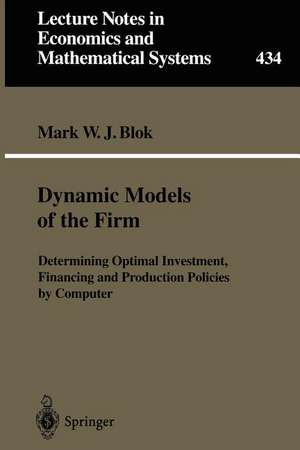Dynamic Models of the Firm: Determining Optimal Investment, Financing and Production Policies by Computer: Lecture Notes in Economics and Mathematical Systems, cartea 434
Autor Mark W. J. Blok, A. T. Kearneyen Limba Engleză Paperback – 7 mar 1996
Din seria Lecture Notes in Economics and Mathematical Systems
-
 Preț: 360.02 lei
Preț: 360.02 lei -
 Preț: 383.93 lei
Preț: 383.93 lei - 15%
 Preț: 693.39 lei
Preț: 693.39 lei -
 Preț: 384.09 lei
Preț: 384.09 lei -
 Preț: 380.07 lei
Preț: 380.07 lei -
 Preț: 446.26 lei
Preț: 446.26 lei -
 Preț: 497.37 lei
Preț: 497.37 lei -
 Preț: 380.84 lei
Preț: 380.84 lei -
 Preț: 384.86 lei
Preț: 384.86 lei -
 Preț: 378.34 lei
Preț: 378.34 lei -
 Preț: 399.67 lei
Preț: 399.67 lei - 20%
 Preț: 360.93 lei
Preț: 360.93 lei - 15%
 Preț: 643.16 lei
Preț: 643.16 lei -
 Preț: 379.09 lei
Preț: 379.09 lei -
 Preț: 404.76 lei
Preț: 404.76 lei -
 Preț: 385.62 lei
Preț: 385.62 lei - 15%
 Preț: 644.49 lei
Preț: 644.49 lei -
 Preț: 379.09 lei
Preț: 379.09 lei -
 Preț: 345.50 lei
Preț: 345.50 lei -
 Preț: 425.80 lei
Preț: 425.80 lei -
 Preț: 378.34 lei
Preț: 378.34 lei - 18%
 Preț: 775.65 lei
Preț: 775.65 lei -
 Preț: 392.60 lei
Preț: 392.60 lei -
 Preț: 401.61 lei
Preț: 401.61 lei - 15%
 Preț: 646.43 lei
Preț: 646.43 lei -
 Preț: 382.18 lei
Preț: 382.18 lei -
 Preț: 378.34 lei
Preț: 378.34 lei - 15%
 Preț: 637.59 lei
Preț: 637.59 lei - 15%
 Preț: 647.27 lei
Preț: 647.27 lei -
 Preț: 377.73 lei
Preț: 377.73 lei -
 Preț: 447.84 lei
Preț: 447.84 lei - 15%
 Preț: 644.49 lei
Preț: 644.49 lei -
 Preț: 386.00 lei
Preț: 386.00 lei - 15%
 Preț: 654.43 lei
Preț: 654.43 lei -
 Preț: 415.02 lei
Preț: 415.02 lei -
 Preț: 411.54 lei
Preț: 411.54 lei -
 Preț: 398.92 lei
Preț: 398.92 lei -
 Preț: 398.92 lei
Preț: 398.92 lei -
 Preț: 392.75 lei
Preț: 392.75 lei - 15%
 Preț: 635.47 lei
Preț: 635.47 lei - 20%
 Preț: 653.56 lei
Preț: 653.56 lei -
 Preț: 379.86 lei
Preț: 379.86 lei -
 Preț: 495.46 lei
Preț: 495.46 lei -
 Preț: 447.99 lei
Preț: 447.99 lei -
 Preț: 378.71 lei
Preț: 378.71 lei - 15%
 Preț: 637.13 lei
Preț: 637.13 lei -
 Preț: 385.84 lei
Preț: 385.84 lei -
 Preț: 378.54 lei
Preț: 378.54 lei - 15%
 Preț: 666.55 lei
Preț: 666.55 lei
Preț: 383.12 lei
Nou
Puncte Express: 575
Preț estimativ în valută:
73.33€ • 79.68$ • 61.64£
73.33€ • 79.68$ • 61.64£
Carte tipărită la comandă
Livrare economică 21 aprilie-05 mai
Preluare comenzi: 021 569.72.76
Specificații
ISBN-13: 9783540608028
ISBN-10: 3540608028
Pagini: 208
Ilustrații: VII, 193 p.
Dimensiuni: 155 x 235 x 11 mm
Greutate: 0.3 kg
Ediția:Softcover reprint of the original 1st ed. 1996
Editura: Springer Berlin, Heidelberg
Colecția Springer
Seria Lecture Notes in Economics and Mathematical Systems
Locul publicării:Berlin, Heidelberg, Germany
ISBN-10: 3540608028
Pagini: 208
Ilustrații: VII, 193 p.
Dimensiuni: 155 x 235 x 11 mm
Greutate: 0.3 kg
Ediția:Softcover reprint of the original 1st ed. 1996
Editura: Springer Berlin, Heidelberg
Colecția Springer
Seria Lecture Notes in Economics and Mathematical Systems
Locul publicării:Berlin, Heidelberg, Germany
Public țintă
ResearchCuprins
1 Introduction.- 2 Mathematical Background to Dynamic Optimization.- 2.1 Introduction.- 2.2 Analytical approach to the optimization problem.- 2.3 Numerical approach to the optimization problem.- 2.4 Economic interpretation of the adjoint variables.- 2.5 General procedure.- 3 The Basic Model.- 3.1 Introduction.- 3.2 The model and its assumptions.- 3.3 Examination of the paths.- 3.4 Case study.- 3.5 Conclusions.- 4 A Model with Start-up Costs.- 4.1 Introduction.- 4.2 The model and its assumptions.- 4.3 Examination of the paths.- 4.4 Case study.- 4.5 Conclusions.- 5 Models with a Business Cycle.- 5.1 Introduction.- 5.2 The basic model.- 5.3 A model with a variable utilization rate.- 5.4 A model with a cash balance.- 5.5 A model with an inventory of finished goods.- 5.6 Conclusions.- 6 A Model with Increasing Returns to Scale, an Experience Curve and a Production Life Cycle.- 6.1 Introduction.- 6.2 Description of the model.- 6.3 Case study.- 6.4 Conclusions.- Appendices.- A Mathematical Details for Chapter 3.- A.1 Problem formulation.- A.2 Necessary conditions for optimality.- A.3 Elaborating the transversality conditions.- A.4 Further examination of some paths.- B Mathematical Details for Chapter 4.- B.1 Problem formulation.- B.2 Necessary conditions for optimality.- B.3 Elaborating the transversality conditions.- B.4 Further examination of some paths.- C Mathematical Details for Chapter 5.- C.1 The basic model.- C.1.1 Determining the coupling points for Subsection 5.2.2.- C.1.2 Determining the coupling points for Subsection 5.2.3.- C.1.3 Deriving relationships (5.22) and (5.27).- C.1.4 Determining the coupling points for Subsection 5.2.4.- C.l.5 Determining the coupling points for Subsection 5.2.5.- C.1.6 Deriving relationships (5.45) and (5.49).- C.2 A model with a variable utilization rate.- C.2.1 Necessary conditions for optimality.- C.2.2 Further examination of some paths.- C.2.3 Determining the coupling points for Subsection 5.3.2.- C.2.4 Determining the coupling points for Subsection 5.3.3.- C.2.5 Determining the coupling points for Subsection 5.3.4.- C.3 A model with a cash balance.- C.3.1 Necessary conditions for optimality.- C.3.2 Further examination of some paths.- C.3.3 Determining the coupling points for Subsection 5.4.2.- C.3.4 Determining the coupling points for Subsection 5.4.3.- C.3.5 Determining the coupling points for Subsection 5.4.5.- C.4 A model with an inventory of finished goods.- C.4.1 Necessary conditions for optimality.- C.4.2 Further examination of some paths.- C.4.3 Determining the coupling points for Subsection 5.5.2.- C.4.4 Determining the coupling points for Subsection 5.5.3.- D Mathematical Details for Chapter 6.- D.1 Necessary conditions for optimality.- Symbols and Notation.- Summary.









